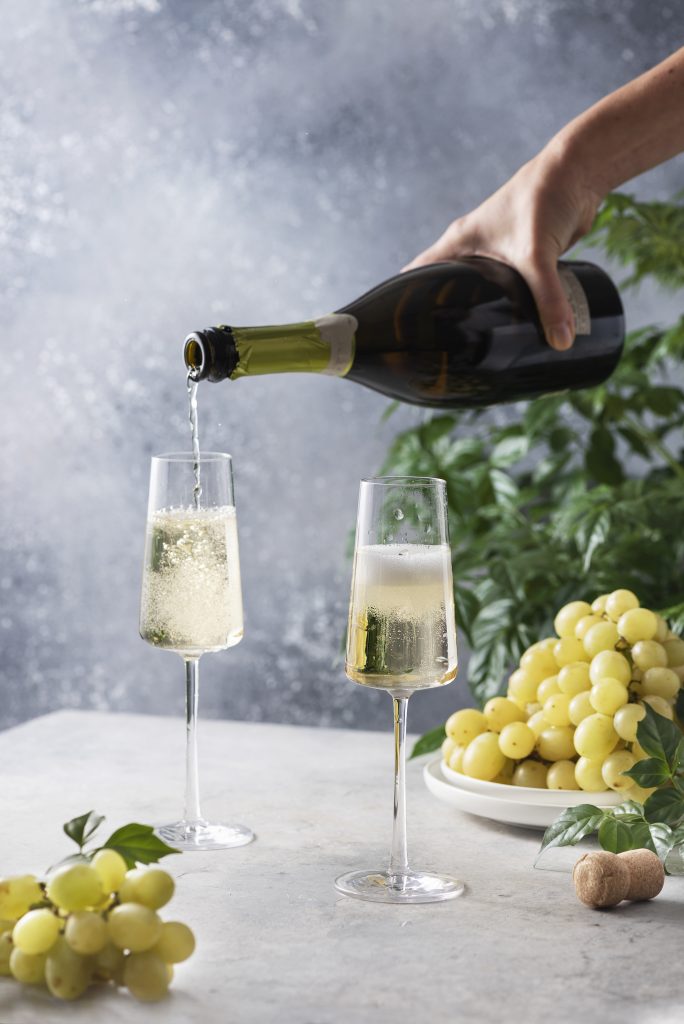In the first part of our journey in the world of sparkling wines, we discussed the traditional method, used for sparkling wines from Champagne and for Spanish cava (and others as well, which we will get to), and about the faster method, Charmat, used in obtaining Prosecco. But these are not the only methods to obtain sparkling wines, and today we continue our trip with other stories, older or newer.
The Asti method
Asti is a sparkling wine from the Piemonte region, produced mainly around the cities of Asti and Alba. Its history seems to begin around 1870, when Carlo Gancia returned from the Champagne region, where he studied the production process of sparkling wines. His first wines were produced in Canelli, which is why you can still find the name Muscat Canelli on some labels, although the common name of the grape is Muscato bianco.
Somewhat similar to the Charmat method, the Asti method is even simpler: the wine does not have a second fermentation. Instead, the first fermentation takes place in special vessels, which partially retain the carbon dioxide, which dissolves in the wine. The fermentation is then interrupted by a very careful filtration, so that the yeasts that may cause a re-fermentation in the bottle are completely eliminated.
The first fermentation is interrupted when the wine is between 7 and 9.5% alcohol and has a residual sugar level (the sugars not consumed by the yeasts) of 30-50 grams/liter.

Asti vs. Moscato d’Asti
These sparkling wines are obtained exclusively from Moscato bianco grapes, and in order to be able to carry the DOCG label (Designation of Controlled and Guaranteed Origin), obtained since 1993, the harvests must not exceed the level of 10 tons / hectare. Moscato bianco, for Romanians, is about the same thing as Tamaioasa romaneasca, both being locally acclimatized versions of the Muscat au petit grains blanc grape.
The characteristic of these extremely popular wines is the intensely floral aroma, in which the note of Muscat (usually associated with dragées and candy bars) feels rather like rose petals, next to well-ripened peaches and even grapes. It is a wine suitable for cakes, but also for spicy dishes, especially Asian, or as an aperitif / dessert.
Attention, however, even if we are talking about Muscat grapes and about the production in the Asti area, Moscato d’Asti is not a sparkling wine, but a relative of it, with a lower level of carbon dioxide and, obviously, a lower pressure in the bottle. For quality sparkling wines the pressure is 5-6 bars, at least twice as much as in your car’s tires, and in no case below 3 bars, Muscato d’Asti is, in fact, a "frizzante", with a pressure between 1 and 2.5 bars. Another important difference between Moscato d’Asti and Asti is the alcohol level, Moscato d’Asti being limited by law to a maximum of 5.5% vol.alc..
With fewer bubbles…
Since we got to frizzante… there is no clear rule for how it should be produced. A frizzante can acquire carbon dioxide both through secondary fermentation in tanks (vessels of thousands or tens of thousands of liters), i.e. by adding sugars and yeasts over a finished wine (in which case the carbon dioxide from the second fermentation remains trapped in the wine ), or by adding carbon dioxide. From this point of view, the Romanian legislation is more restrictive and imposes clearer definitions – however, the subtle differences between sparkling and sparkling, on the one hand, and pearly / sparkling / semi-sparkling, on the other hand, this categorization remain largely unknown to the general public.
For an easier transition to other bubbles, let’s note here that there are also sparkling wines without added carbon dioxide, which also do not go through secondary fermentation, but through "refermentation". What’s the difference? If the secondary fermentation is caused by the addition of yeasts and sugars, the re-fermentation takes place when the normal fermentation process is stopped, the wine is bottled (without filtration), after which the primary fermentation continues in the bottle, until a CO2 pressure that remains within the limits 1-2.5 atmospheres. In general, on the labels of sparkling wines that use this method, the mention "rifermentato" appears. There is Prosecco frizzante (although most often it is "spumante") and you will often meet Lambrusco (the most popular red frizzante), Moscato d’Asti (see above) and Friesa (from Friesa grapes, also from Piemonte).
Around the world, frizzante is also called vino de aguja (Spain), vinho frizzante (Portugal), pettilant (France) or perlwein (Germany).

Let’s get things even more complicated with Sekt!
Perlwein is one of the wines of the world that connoisseurs point to as oscillating between "horrible" and "decent" and, always, they are obtained by adding carbon dioxide over a base wine. No re-fermentation, no complications, any wine that is a bit difficult to drink becomes more siphonable or "spritzed" when it has a little pinch of carbonic acid.
But German sparkling wines are a bit more complicated and can often hold surprises. It’s not for nothing that Germans drink at least 5 bottles per year (per capita), and Austrians about 4. That is, out of the 2 billion bottles produced annually, Germans drink about 420 million (and import just as many). Unfortunately, the name of Sekt will not be cleansed too soon, although efforts are being made to promote the idea of quality Sekt. Winzersekt, produced according to the traditional method, with refermentation in the bottle, only represents 1.7% from the above-mentioned production (Decanter.com, Anne Krebiehl MW, 06.02.2023). And the big share is obviously down there, at the 5 euro bottles on the store shelf, a vague equivalent of 1.5-2 euros at the winery door.
There is, therefore, good Sekt, even if rarer, and the easiest way to recognize it is by the inscription "Traditionelle Flaschengärung" (traditional method), or "klassische". And, because it is Germany and nothing can be simple, next to this inscription you can also discover the details:
- VDP.Sekt – aging on yeast for a minimum of 15 months
- VDP.Jahrgangssekt (with the harvest year written on the label) – minimum 24 months on yeast
- VDP.Sekt Prestige – minimum 36 months on yeast
In contrast to these, Sekt b.A. (Sekt bestimmter Anbaugebiete), can come from any of the 13 German wine regions, but the second fermentation can take place both in the bottle and in the tank (and we are still discussing good Sekt).
Cremant at Champagne standards and bulk wines
In certain areas of Germany, closer to the border with France, there is also Cremant, a term also used in Spain, Luxembourg, Switzerland or in France (in areas other than Champagne, especially in Alsace and Burgundy). If we go by the regulations, Cremant is the absolute pinnacle of German sparkling wine quality), the law imposing even more drastic rules than Winzersekt: the grapes must be picked manually, they must be pressed whole, without destemming, and the quantity obtained cannot exceed 100 liters each 150 kilograms of grapes. Secondary fermentation and susequent ageing on yeast cannot take less than 9 months. Although all 13 wine-growing regions have the right to use the name of Cremant, as long as they follow the rules, of the approximately 70 producers who make this wine, 59 are from Baden, Pfalz and Mosel.
And, after all this, why is the Sekt still pointed with the finger, as being of inferior quality? Simple, because on more than 90% of the bottles you will only find the name "Sekt", which means that it can be any wine, from anywhere in Europe, produced in any possible anyway, brought in bulk and enriched with carbon dioxide or re-fermented in Germany. And, when it reaches the shelf after so many journeys, at such a price, without an anti-hangover treatment, it is pretty risky…








